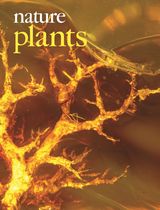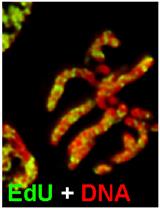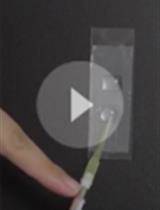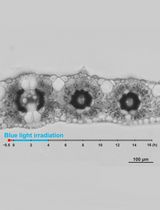- EN - English
- CN - 中文
Biomechanical Characterization of Onion Epidermal Cell Walls
洋葱表皮细胞壁的生物力学表征
发布: 2017年12月20日第7卷第24期 DOI: 10.21769/BioProtoc.2662 浏览次数: 12270
评审: Manjula MummadisettiAlexandros AlexandratosAnonymous reviewer(s)
Abstract
Here we describe two experimental protocols to measure the biomechanical properties of primary (growing) plant cell walls, with a focus on analyzing cell wall epidermal strips of onion scales. The first protocol measures cell wall creep (time-dependent irreversible extension) under constant force. Such creep is often mediated by the wall-loosening action of expansin or selective endoglucanases. The second protocol is based on two consecutive stretches of the wall and measures the wall’s elastic and plastic compliances, which depend on cell wall structure. These two assays provide complementary information that may be linked to cell wall structure and expansive growth of cells.
Keywords: Cell walls (细胞壁)Background
The primary walls of growing plant cells are strong enough to resist the tensile forces generated by cell turgor pressure, yet can expand irreversibly during cell growth as a result of the selective loosening action of expansins or other catalysts necessary for irreversible cell wall enlargement (Cosgrove, 2016a and 2016b). Assessments of cell wall mechanical properties, such as elasticity and plasticity, are important for understanding cell wall structure and its modification during growth (cell enlargement) and after growth ceases. An important measure of wall mechanics is based on uniaxial tensile tests, as described below in our stress/strain assay, which measures elastic and plastic compliance (compliance is the reciprocal of modulus; modulus is a measure of stiffness). A second, complementary assay is based on the irreversible, time-dependent increase in length (creep) that occurs in primary cell walls when they are held at constant tension and continuously loosened by endogenous expansin or exogenous endoglucanase (Durachko and Cosgrove, 2009; Cosgrove, 2011; Cosgrove et al., 2017). In this protocol, we describe procedures for preparing epidermal cell wall strips from onion scales and testing them in these two assays. Onion epidermal cell walls provide a useful model to explore the connection between cell wall structure and biomechanics (Wilson et al., 2000; Suslov et al., 2009; Kim et al., 2015; Zhang et al., 2017; Zheng et al., 2017).
Materials and Reagents
- Single edge razor blades (e.g., VWR, catalog number: 55411-050 )
- Double edge razor blades (e.g., Safety Razor Company, catalog number: 74-0002 )
- Disposable Petri dishes (e.g., Corning, Falcon®, catalog number: 351007 )
- Double sided ½ inch wide ‘Scotch’ tape
- Masking tape or similar (e.g., VWR, catalog number: 89097-920 )
- 25 x 75 mm, 1.0 mm thick microscope slides (e.g., VWR, catalog number: 48300-025 )
- 22 x 22-1.5 microscope cover glass (e.g., Fisher Scientific, Fisherbrand, catalog number: 12-541-B )
- White onion (Allium cepa L.) bulbs; we use the Cometa cultivar
- Distilled-deionized water (ddH2O)
- Sodium acetate trihydrate (e.g., VWR, catalog number: BDH9278-500G )
- HEPES (e.g., VWR, catalog number: 97061-826 )
- Hydrochloric acid (e.g., Merck, catalog number: HX0603-75 )
- Acetic acid (e.g., Merck, catalog number: AX0073-6 )
- HEPES buffer (20 mM, pH 6.8) (see Recipes)
- Sodium acetate buffer (20 mM, pH 4.5) (see Recipes)
Equipment
- Microwave oven, hot plate, or Bunsen burner
- pH meter (e.g., Corning, model: Model 430 )
- Analytical balance (e.g., Mettler Toledo, model: XPE105 )
- Fine forceps (e.g., Dumont No. 5)
- Flat tip forceps (e.g., Rose Scientific, catalog number: FF-001 )
- Custom 3 mm slicing jig (see Notes section)
- Microcomputer
- Data acquisition hardware (e.g., Data Translation, model: DT9801 )
- Constant-force extensometer (Figure 1) (Durachko and Cosgrove, 2009; Cosgrove, 2011; Cosgrove et al., 2017)
- Stress/strain analyzer (Figure 2) (Cosgrove, 2011; Cosgrove et al., 2017)

Figure 1. The constant-force extensometer. A vertically adjustable, open clamping chamber fixes the bottom of the wall sample and is capable of holding liquid with a capacity of roughly 150 microliters. A second clamp is applied to the upper portion of the wall sample and is connected to a balanced lever. Displacement of the lever and connecting rod is monitored using a linear variable displacement transducer (LVDT), e.g., Schaevitz 050HR. Weights are applied to the lever to modulate the tension on the sample. Custom software displays and records displacement and calculated extension rates. We use a bank of eight of these units connected in parallel to a microcomputer via a data acquisition module (Data Translation DT9801).
Figure 2. The device used for stress/strain assays. A. The vertical stage is controlled by a PC serial port stepper driver (e.g., AutomationDirect STP-DRV-4850), stepper motor (e.g., Lin Engineering 4218L-01D-02), geared belt drive, and lead screw assembly. Stage position is monitored with an LVDT. Tension is monitored with an s-type load cell (e.g., Futek LSB200 100 g). Custom software controls the strain rate and tension. Two clamps hold the sample being measured. The upper clamp is fixed to the movable stage. The lower clamp is fixed to the load cell. B. Close up of peel affixed between clamps (peel stained blue to aid visualization for this image). C. Alternate view of device noting specific pieces.
Software
- Custom software written using Microsoft Visual Basic is used for acquiring data and some data analysis. Microsoft Visual Basic may be freely downloaded at http://www.microsoft.com. Alternatively, many commercial software packages are available both free and for purchase to allow data acquisition and analysis
Procedure
文章信息
版权信息
© 2017 The Authors; exclusive licensee Bio-protocol LLC.
如何引用
Durachko, D. M., Park, Y. B., Zhang, T. and Cosgrove, D. J. (2017). Biomechanical Characterization of Onion Epidermal Cell Walls. Bio-protocol 7(24): e2662. DOI: 10.21769/BioProtoc.2662.
分类
植物科学 > 植物细胞生物学 > 细胞结构
您对这篇实验方法有问题吗?
在此处发布您的问题,我们将邀请本文作者来回答。同时,我们会将您的问题发布到Bio-protocol Exchange,以便寻求社区成员的帮助。
提问指南
+ 问题描述
写下详细的问题描述,包括所有有助于他人回答您问题的信息(例如实验过程、条件和相关图像等)。
Share
Bluesky
X
Copy link













